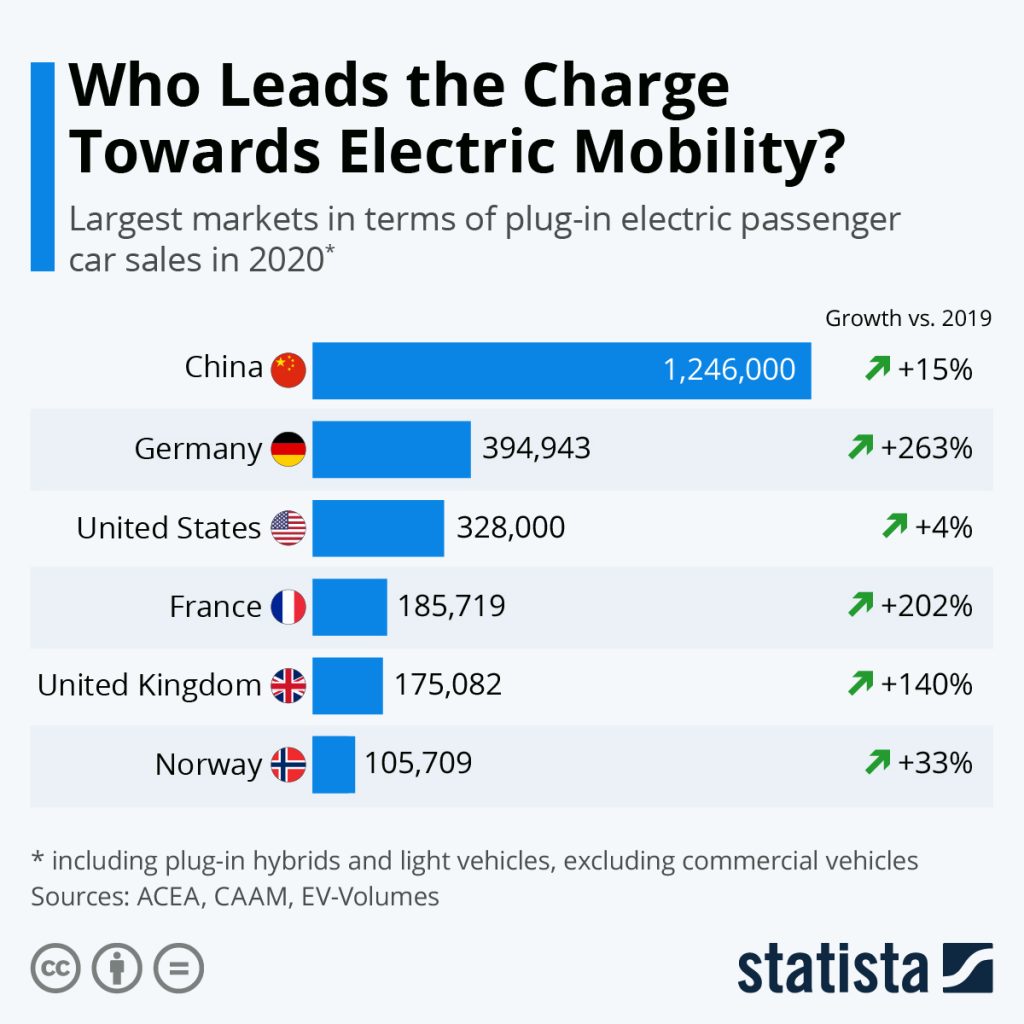Electric vehicle (EV) usage has been on the rise in recent years. By the end of 2020, a reported 10.8 million electric vehicles were on the road worldwide. Sales of battery-electric vehicles (BEV) and plug-in hybrid vehicles (PHEV) increased by 137% from 2019 (Zap Map, 2021).

China boasts the biggest EV market, but Norway is the country with by far the biggest share of electric cars in total passenger car sales. Norway’s policy measures, which include tax exemptions and other incentives, promote EV adoption and help lead the way in the fight towards a thrivable future for all (Richter. F, 2021).

Why have electric vehicle sales risen so much?
Several factors have contributed to the rise of EV usage. Government incentives, subsidies, grants, and intensive promotion are largely to thank, along with increased global awareness of environmental issues (Adler. K, 2021).
Heard of the Fossil Fuel Free Streets Declaration? An initiative born of the C40 Cities Climate Leadership Group, it’s a pledge by major cities to transition to fossil-fuel-free streets by 2030. This will be achieved through reducing the number of polluting vehicles, creating ‘people-friendly planning policies’ and ‘increasing the rates of walking, cycling and the use of public and shared transport…’.
Electric vehicle projections
Some projections predict that global sales of BEV and other EVs will rise by 70% in 2021 (Adler. K, 2021).
For 2021, China and Europe will account for the largest market shares by far, with China at about 44% and Europe at nearly 28%. Lagging behind are North America with a 16% share, and a combined Japan/South Korea share of 11%.
Source: IHS Markit
The COVID-19 pandemic has had an effect on EV production, especially in China, where several manufacturers had to stop production. Despite the pandemic-induced hiccups, around 450 new electric vehicle models are set to be launched in 2022, which will undoubtedly increase global EV uptake.
Battery-cell manufacturers are also increasing their production capacities to match consumer demand, which will lower prices and encourage uptake. Battery costs have decreased by 85% since 2010, in addition, ‘the ongoing trend of increasing battery capacity is projected to continue. By 2030, battery electric vehicles are assumed to reach an average driving range of 350-400 km’.
Infrastructure investment is key
One obstacle to the significant uptake of electric vehicles is the availability of charging stations. In Australia, over 50% of motorists said that access to electric vehicle charging stations is a key barrier to EV adoption (Infrastructure Australia, 2019).
Electrified transportation is still beset by the classic chicken-and-egg problem: Fuel providers will not invest in fueling infrastructure until enough EVs are in circulation, and people will avoid buying an EV until sufficient charging points exist.
Source: World Economic Form
Volkswagen’s subsidiary, Electrify America, is building a massive charging network in the US. This move follows the lead of Telsa, who have already installed 20,000 charging stations globally. Despite the investment from auto manufacturers, public and home-based electric vehicle charging systems are still thin on the ground (The Verge, 2018).
Building new charging stations can be a bureaucratic mess and it typically involves navigating layers of red tape, dealing with the local utility company, and persuading business owners to hand over a piece of their real estate.
The challenges
The most significant challenges to rolling out more charging points are:
- The installation of home charging stations in shared apartments pose the threat of competing interests in common spaces used by multiple residents.
- Increasing electrical loads on buildings’ current power systems.
- Financial and technical issues with installation.
- Unclear regulation surrounding charging point installation.
- High upfront cost of public charging stations relative to low uptake.
- Lack of clear direction about who is responsible for funding charging points.
The availability and convenience of charging is one of the key factors to ensure a good driving experience for EV owners. Therefore, the deployment of charging infrastructure is essential to facilitate the uptake of plug-in EVs and the sustainable development of the plug-in EV industry.
Source: IDTechEx
Towards zero emission mobility
Governments have a responsibility to define who is accountable for funding vehicle charging points. In addition, financial policies can go a long way in creating incentives for electric vehicle owners and building owners.
Ensuring that poor infrastructure doesn’t stand in the way of EV uptake requires a collaborative effort and increased understanding. Places, such as Vancouver are leading the way with electric vehicle charging infrastructure: As of 2019, all new multi-family residential developments must have EV charging capabilities in every parking space.
When effective government policy combines with public demand for more reliable EV charging networks, we can all inch closer to zero-emission mobility.
Want to learn more? Join us at the THRIVE Project to create a THRIVEable planet together. Find out more here.


